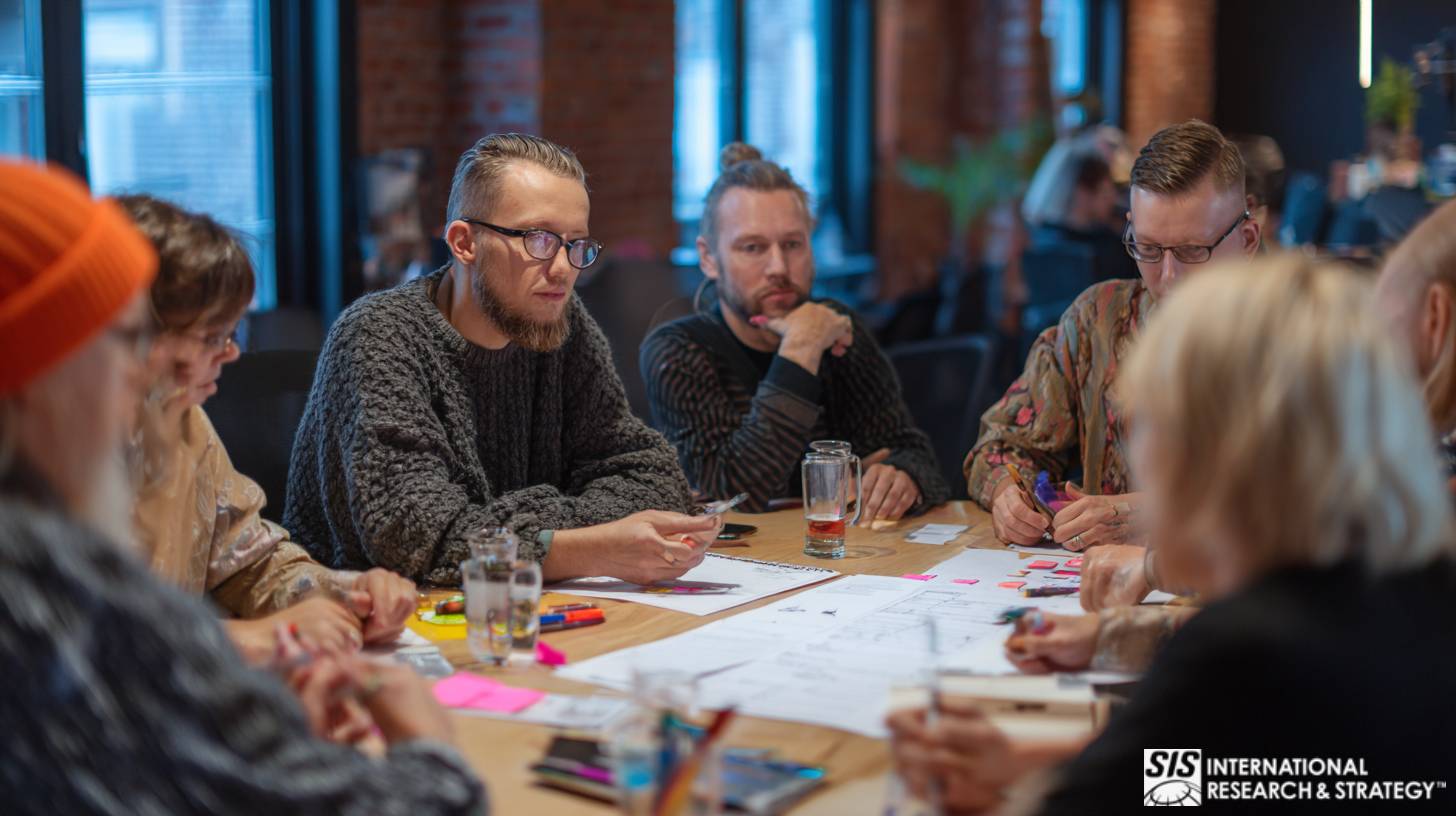Cos'è un Focus Group?

A focus group isn’t about collecting yes or no answers. It’s about understanding the “why” behind every decision your customers make.
A focus group brings together a small group of people who represent your target audience. Think of it as organized conversation with a purpose. These sessions give you insights that surveys and data spreadsheets simply can’t capture. You’ll see real reactions, hear genuine concerns, and discover what truly matters to your customers.
Here’s what makes focus groups different—you’re watching human behavior unfold in real time. You get the raised eyebrows, the excited nods, the uncomfortable silences.
Table of Contents
The Anatomy of a Focus Group
Every focus group has three critical players working together.
The Participants
Your participants are the heart of any focus group. These aren’t random people pulled off the street—they’re carefully chosen because they match your target demographic. Maybe you’re researching luxury car buyers in Singapore, so you’ll recruit high-income professionals aged 35-55. Or perhaps you’re testing a new fitness app for busy parents in London.
The magic happens when you get 6-8 people in a room together. Any fewer and the conversation feels thin. Any more and quieter voices get drowned out.
The Moderator
Think of the moderator as the conductor of an orchestra. This person needs to keep the conversation flowing without controlling what people say. Great moderators create psychological safety. They make participants comfortable enough to share brutal truths about your product or service.
A skilled moderator also knows when to dig deeper. If someone mentions they “just don’t trust” a new banking app, a good moderator will probe that feeling. What specifically triggers that distrust? The color scheme? The company’s reputation? A past bad experience with digital banking?
The Observer
Observers sit behind the scenes, watching everything unfold. They’re your research team members who need to see reactions firsthand.
When Should You Run a Focus Group?

Not every research question needs a focus group. But certain situations practically demand one.
Testing New Products Before Launch
Let’s say you’re developing a meal-kit delivery service for the Toronto market. Sure, you’ve done market analysis showing demand exists. But a focus group reveals the details that make or break success. You discover that your target customers in Canada actually want locally-sourced ingredients more than exotic international recipes. That insight just saved you from a costly positioning mistake.
Understanding Confusing Customer Behavior
Your analytics show a 70% cart abandonment rate, but the numbers don’t tell you why. A focus group can uncover the real story. Maybe your checkout process feels too intrusive. Perhaps shipping costs aren’t transparent early enough. Or maybe—and this happens more than you’d think—customers simply can’t find the “complete purchase” button.
Test dei messaggi di marketing
Before you spend six figures on an advertising campaign, test it with a focus group. One financial services firm created what they thought was an empowering campaign about “taking control of your financial future.” Focus groups showed that the phrase actually made people feel anxious and inadequate. The revised messaging focused on “building financial confidence step by step”—and that resonated deeply.
Digging Beyond the Numbers
Sometimes your quantitative data raises more questions than it answers. Your customer satisfaction scores are decent but not great. A focus group helps you understand what “satisfied” really means to your customers and what it would take to delight them instead.
Key Focus Group Research Statistics
| Research Element | Standard/Statistic | Fonte |
|---|---|---|
| Ideal Group Size | 6-8 participants for most research topics | Civicom Market Research |
| Mini Focus Groups | 4-5 participants for complex or sensitive topics | InterQ Research |
| Session Duration | 90 minutes maximum to maintain participant engagement | Faculty Focus |
| Code Saturation | 94% of codes identified within 4 focus group sessions | National Institutes of Health |
| Theme Discovery | 80% of themes discoverable within 2-3 focus groups | Sage Journals |
| Comprehensive Coverage | 90% of thematic content captured with 3-6 focus groups | Sage Journals |
| Participant Range | 3-12 participants commonly used depending on study complexity | Faculty Focus |
| Typical Applications | Used across multiple sectors including healthcare, technology, and consumer products | BMC Medical Research Methodology |
What Is a Focus Group? Different Types of Focus Groups You Can Run
The traditional focus group setup isn’t your only option. Different situations call for different approaches.
The Classic One-Way Focus Group
This is your standard format—a moderator guides participants through discussion topics while observers watch from another room or behind a one-way mirror. It’s straightforward, time-tested, and effective for most research goals. A focus group like this works brilliantly when you’re testing consumer reactions to product prototypes or exploring opinions about a new service concept.
Two-Way Focus Groups
Here’s where things get interesting. One focus group discusses a topic while a second group watches and then provides their own perspective. This layered approach works well for complex B2B decisions where you need insights from different stakeholder groups. A software company might have IT managers in one focus group discussing security features, while C-suite executives watch and then discuss their priorities in a second session.
Mini Focus Groups
Sometimes smaller is better. Mini focus groups with just 4-5 participants create intimacy that larger groups can’t match. These work exceptionally well for sensitive topics like healthcare decisions or financial services.
Focus group on-line
Digital focus groups exploded in popularity recently, and they’re not just a fallback option. Remote focus groups give you access to participants across different geographies without travel costs. You can recruit a diverse mix of people from Vancouver, London, and Manchester for the same session.
But online focus groups require careful moderation. Without physical presence, it’s easier for participants to disengage.
The Real Advantages of Focus Groups
Your focus group is only as good as your participants. You need people who genuinely represent your target market and can articulate their thoughts clearly.
A focus group delivers value that other research methods can’t match.
✅ You capture the human element. Surveys tell you what people think. A focus group shows you how they feel. You see excitement, skepticism, confusion, delight—all the emotions that drive actual buying decisions.
✅ Group dynamics spark unexpected insights. When participants build on each other’s comments, they often reach conclusions that nobody would’ve voiced in an individual interview. One participant mentions a pain point, another says “oh, that drives me crazy too,” and suddenly you’ve uncovered a critical issue your team never even considered.
✅ You can test and iterate in real-time. Bring multiple concepts to a focus group and gauge reactions on the spot. A fashion retailer tested three different store layout concepts in a single two-hour session. Participant feedback clearly favored one approach, saving months of deliberation.
✅ You get immediate, detailed feedback. There’s no waiting weeks for survey responses or trying to interpret cold data. A focus group gives you rich, contextual feedback you can act on quickly.
✅ You can explore the “why” behind behavior. Data shows you what’s happening. A focus group explains why it’s happening. That’s the difference between knowing your app has a 60% churn rate and understanding that users abandon it because the onboarding process feels overwhelming.
The Limitations You Need to Understand
No research method is perfect, and focus groups come with real constraints.
⚠️ Small sample sizes limit generalization. Eight people in a focus group can’t represent your entire market. Their opinions matter, but don’t assume 80% of focus group participants agreeing means 80% of your market will agree. Use focus groups for deep insights, but back them up with quantitative research when you need statistical confidence.
⚠️ Group dynamics can skew results. Dominant personalities might influence quieter participants. Someone with strong opinions and an authoritative presence can shift the whole group’s perspective.
⚠️ Moderator bias is a real risk. The way a moderator asks questions or reacts to responses can inadvertently guide participants toward certain answers. A moderator who nods enthusiastically at some comments but stays neutral on others is subtly influencing the conversation.
⚠️ Analysis can be subjective. Unlike numerical data, focus group transcripts require interpretation. Two analysts might emphasize different themes from the same session. That’s why having multiple observers and a structured analysis framework matters.
⚠️ They’re time and resource-intensive. Between recruitment, incentives, facility rental, moderator fees, and analysis time, focus groups aren’t cheap. One session can easily cost thousands. And if you need to run multiple groups to cover different segments? That budget adds up quickly.
Focus Group Research Effectiveness
Percentage of themes and insights captured by number of sessions
Focus Groups vs. In-Depth Interviews: Which Should You Choose?
Both are valuable qualitative research tools, but they serve different purposes.
A focus group shines when you want to see how people interact around a shared topic. The group dynamic itself becomes data. You’re watching social influence, consensus-building, and disagreement play out. This works brilliantly for testing concepts that people experience socially—like restaurant dining, entertainment choices, or workplace technology.
In-depth interviews excel when you need deep, personal perspectives without any social pressure. Discussing sensitive financial situations, health concerns, or personal failures? Individual interviews let people open up in ways they never would in a group setting.
Making Focus Groups Work for Your Business
If you’re going to invest in focus groups, do them right.
Don’t treat them as the sole basis for major decisions. A focus group should inform your strategy, not determine it entirely.
Run multiple sessions across different segments. One focus group tells you something. Three or four focus groups start revealing patterns. If you’re targeting both millennials and baby boomers, run separate sessions for each group. Geographic differences matter too—a focus group in New York might yield different insights than one in Birmingham or Singapore.
Time them strategically in your development process. Early-stage focus groups help validate concepts and identify potential problems. Mid-development sessions test specific features or design elements. Pre-launch focus groups fine-tune messaging and positioning. Each stage requires different questions and objectives.
Combine them with other research methods. Use surveys to quantify what you learned qualitatively. If focus group participants love a particular feature, test whether that preference holds up across a larger sample. Let analytics track whether the behaviors people describe in focus groups actually match their real-world actions.
Choose your moderator carefully. This person can make or break your results. You need someone who’s skilled at group facilitation, knowledgeable about your industry, and genuinely curious about human behavior. Don’t just assign this role to whoever’s available.
The Bottom Line on Focus Groups
A focus group is one of the most powerful tools in your research arsenal. It gives you access to the messy, complex human thinking that drives real behavior. You see how people respond emotionally to your ideas. You discover objections you never anticipated. You find opportunities hiding in plain sight.
… But a focus group isn’t a magic solution that solves all research questions. It’s one tool among many. Use it when you need qualitative depth, when group interaction will surface insights, and when you’re prepared to act on what you learn—even if it contradicts your assumptions.
The best business decisions come from truly understanding your customers. And sometimes, the fastest way to that understanding is sitting down with a small group of them and having an honest conversation. That’s what a focus group delivers—unfiltered access to the people who ultimately determine your success or failure.
La nostra sede a New York
11 E 22nd Street, Piano 2, New York, NY 10010 T: +1(212) 505-6805
A proposito di SIS Internazionale
SIS Internazionale offre ricerca quantitativa, qualitativa e strategica. Forniamo dati, strumenti, strategie, report e approfondimenti per il processo decisionale. Conduciamo anche interviste, sondaggi, focus group e altri metodi e approcci di ricerca di mercato. Contattaci per il tuo prossimo progetto di ricerca di mercato.

